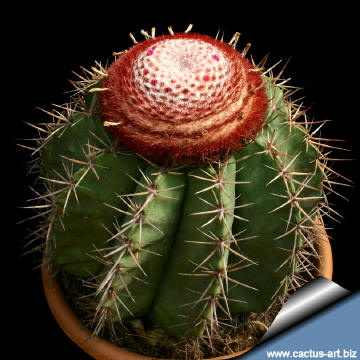|

This is not two plants
grafted together, this is
Melocactus zehntnerii the lower green part that looks
like a barrel cactus is its juvenile body, the upper part is its
adult body, the apical cephalium.

Discocactus hortii the white flowers flower buds will
form from the cephaliu. |
Cephalium is a woolly and bristly swelling at
the top or side of certain cactus species in which flower buds
and fruits are formed, it is frequently brightly coloured..
Melocactus have this densly spined crown and can take a number
of colours, forms and shapes. The cephalium will only begin
growing after a cactus has reached maturity, at which time the
plant quits growing. No other family of plants has members that
undergo such a striking phase change
The areoles at the crown of the plant modify to form a large
amount of wool and bristles. This cephalium can grow for many
years. Once flowering begins the flower buds will form from the
cephalium , and because it is located at the upper end of the
shoot, it is an apical cephalium.
The largest part cacti undergo little or no noticeable change in
growth pattern once they undergo their phase change from
juvenile to adult condition: an old, adult plant capable of
flowering looks just like a young, juvenile plant. However, in
cephalium-bearing genera like Melocactus, the phase change is
accompanied by a dramatic change in growth pattern and body
form, The adult body form differs so greatly from the juvenile
that many people assume that the plant is actually two separate
genera grafted together. Excellent examples occur in Melocactus.
All species of Melocactus grow initially as globose cacti with
spherical, green bodies with strong, widely spaced curved spines
that protect the shoot but do not shade it significantly. The
plants grow like this for years without ever flowering. Once old
enough , the plants switch to being adults the apical shoot
starts to produce the cephalium, it became narrower than that of
the juvenile, spines being shorter and straighter and so
abundant that – combined with the close packing of the wooly
areoles completely protects the adult surface from animals,
sunlight, fungi, bacteria With no light whatsoever penetrating
the mass of spines and the cephalium completely lacks
chlorophyll.
The protection offered by the cephalum is remarkable and also
its morphology makes less expensive for the plant to produce a
flower.
But the positive benefits of having an apical cephalium are
accompanied by negative consequences as well. Once each plant
switches from the juvenile to the adult phase, it becomes
incapable of producing any new chlorophyllous, photosynthetic
tissue. |
|
Apical cephalia occur also on Discocactus and
Backebergia. Discocacti are small, globose cacti like melocacti,
but plants of Backebergia are giant, highly branched columnar
cacti.
(See also
pseudocephalium) |